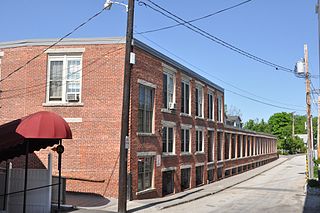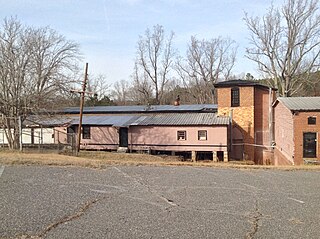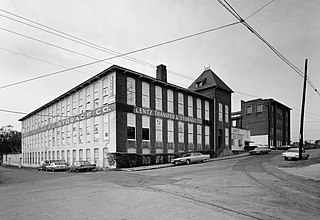
Hudson is a town in Caldwell County, North Carolina, United States. The population was 3,776 at the 2010 census. It is part of the Hickory–Lenoir–Morganton Metropolitan Statistical Area.

Henry River Mill Village is a small textile village in Burke County, North Carolina. It is an unaltered, but now-decaying example of an early industrial environment in Burke County. Today, the remaining buildings of the Henry River Mill Village are traces of the industrial heritage of the county.

The Coleman Manufacturing Company (1897–1904) had the first cotton mill in the United States owned and operated by African Americans. Organized in 1897 by Warren Clay Coleman and others, and operating under original leadership until 1904, it was located in the Piedmont area about two miles from the county seat of Concord, North Carolina in Cabarrus County. Textile manufacturing had been established here before the American Civil War, but the mills hired only white industrial workers. The Coleman property later became part of Franklin Cotton Mills and a Fieldcrest Cannon plant.

The Nashua Manufacturing Company Historic District in Nashua, New Hampshire, is a historic district that was listed on the National Register of Historic Places (NRHP) in 1987. It encompasses an area just west of downtown Nashua, roughly located along the southern bank of the Nashua River, bordered on the west side by Mine Falls Park, on the south side by the Nashua River canal, up to Ledge Street, and from the east side by Factory, Pine and Water streets, up to the Main Street bridge.

The Milford Cotton and Woolen Manufacturing Company is a historic mill complex at 2 Bridge Street in the center of Milford, New Hampshire. Developed between 1813 and World War I, it is one of the few surviving mill complexes in Milford, whose name is derived in part from "mill". The buildings were listed on the National Register of Historic Places in 1982. The complex has been converted into residential use.
The Oneida Cotton Mills and Scott-Mebane Manufacturing Company Complex, also known as the Scott and Donnell Mill, is a historic hosiery mill building in Graham, Alamance County, North Carolina. It consists of four contributing buildings and one contributing structure. The buildings date from 1882 into the 1940s; all are red-brick except for a small shed-roofed bathroom building from the 1940s. The complex includes the Scott and Donnell Mill, a smokestack (1882), Holt Mill, Scott-Mebane Manufacturing Company, and opener Room.
Dunavant Cotton Manufacturing Company, also known as Alpine Cotton Mill No. 1, is a historic cotton mill located at Morganton, Burke County, North Carolina. It is a two-story, brick-clad, side gable-roofed building. The original section was built in 1888–1910, with additions and expansions through 1966. The additions to the building, made in the mid to late 1960s were removed in 2012 to reveal the original 1888-1910 mill building. It is the oldest cotton textile mill in Morganton, and was in use as a cotton textile mill until 1949.

Double Shoals Cotton Mill is a historic post-Civil War textile mill located at Cleveland County, North Carolina. It is a 2 1/2-story, brick building with a shallow-pitched, side-gable-roof and Italianate style design elements. Also on the property are a contributing mill race and dam, built about 1880.

Durham Hosiery Mill is a historic textile mill complex located at Durham, Durham County, North Carolina. It includes seven contributing brick buildings in the complex. The original Durham Hosiery Mill was built in 1902, and consists of a four-story main building with a six-story Romanesque Revival-style tower in front; engine, boiler, and heater houses attached at the rear, and a one-story dye house. The main building was expanded with a two-story annex in 1904, and a three-story annex in 1906. Other buildings include the triangular Annex No. 1 (1912) and a three-story brick finishing building. By 1910, the Durham Hosiery Mills Corporation was the largest manufacturer of cotton hosiery in the world. The mill was abandoned in 1922.

Erwin Cotton Mills Company Mill No. 1 Headquarters Building, also known as Erwin Square, is a historic textile mill complex located at Durham, Durham County, North Carolina. The mill was built in 1892, and is a two-story, 748 feet long, brick building. It features three square towers projecting from the east facade and hundreds of large and closely spaced windows. The building exemplifies "slow burn" construction with its exterior load bearing brick walls and its heavy timber heart pine beams and columns. The headquarters building is a Late Victorian style brick building built in 1892 and enlarged in 1896 and 1905. Attached to the headquarters building is a warehouse. In 1983–1984, the complex was renovated as offices and apartments.

Arista Cotton Mill Complex, also known as Salem Cotton Manufacturing Company and Arista Cotton Mill and Lentz Transfer & Storage Co., is a historic cotton mill complex located at Winston-Salem, Forsyth County, North Carolina. The complex includes two buildings: a brick building built in 1836 by part of the Moravian congregation of Salem and the original home of the Salem Cotton Manufacturing Company, and the other is the original Arista Mill, built in 1880 by F. and H. Fries Cotton Arista Mills. The 1836 Salem Cotton Mill is a three-story, brick building with a monitor roof. The 1880 mill is a three-story brick building, 14 bays long, with bracketed eaves with timber supports. A two-story roughly triangular brick building was added about 1900. The 1836 building has been converted to a hotel known as The Historic Brookstown Inn.
Mount Holly Cotton Mill, also known as Alsace Manufacturing Co., is a historic cotton mill complex located at Mount Holly, Gaston County, North Carolina. The original section was built in 1875, and is a 3 story, rectangular brick mill building with Industrial Italianate detailing. A three-story addition was built in 1916, and a one-story, T-plan brick machine shop and boiler house was added in 1919. The complex was converted into a research unit in 1953, and in 1973 was sold to an independent mill operator who presently uses the building for a variety of industrial and commercial purposes.

Oakdale Cotton Mill Village is a historic textile mill, mill village, and national historic district located at Jamestown, Guilford County, North Carolina, United States. The district encompasses 37 contributing buildings including the Logan Manufacturing Company complex built during the 1880s and 33 frame mill worker houses dated to the early-20th century. The factory complex consists of a three-story rectangular brick office, a one and two-story L-shaped brick factory with a four-story tower and five one-story brick warehouses, a small one-story board-and-batten blacksmith shop, and a polygonal brick smokestack.

Eureka Manufacturing Company Cotton Mill, also known as Tait Yarn Company and Lincoln Bonded Warehouse Company, is a historic cotton mill located at Lincolnton, Lincoln County, North Carolina. It was built between 1907 and 1910, and is a two-story, brick factory building with a three-story stair tower. Adjacent to the factory is a two-story brick office building built between 1902 and 1906. The buildings housed the Eureka Manufacturing Company from 1906 to 1937, and Tait Yarn Company from 1949 to 1966. Lincoln Bonded Warehouse occupied the buildings into the late-1990s. The buildings are owned by the Lincoln County Historical Association.

Capitola Manufacturing Company Cotton Yarn Mill, also known as the Marshall Mill and Power Company, is a historic cotton mill complex located at Marshall, Madison County, North Carolina. The main mill building is a three-story brick building built about 1905. It was raised to three stories in 1928. It measures approximately 108 feet (33 m) by 116 feet (35 m), with a low-pitched gabled roof, and windows on three sides. Also on the property is a contributing boiler house and water tank.

Orient Manufacturing Company-Chadwick-Hoskins No. 3, also known as Alpha-Orient Cotton Mill, is a historic cotton mill located at Charlotte, Mecklenburg County, North Carolina. It was built in 1901–1902, and is a two-story, Romanesque Revival style brick building. It incorporates portions of an original mill building built about 1889. The building has a low, front gable roof with exposed rafters, brick exterior walls, and segmental arched windows. It features a three-story staircase tower with a castellated parapet, tall, narrow windows, and a round arched entrance.
Savona Mill, also known as Savona Manufacturing Company, Alfred Cotton Mill, and Old Dominion Box Company, is a historic textile mill located at Charlotte, Mecklenburg County, North Carolina. The building consists of four sections, three of which are historic. They are the 1915-1916 Weave Mill, a one-story rectangular brick building with segmental arched head windows, a low gable roof with exposed beam ends and a wood clerestory monitor roof; the 1921 Spinning Mill, a three-story rectangular brick building with large rectangular steel windows; and the 1951 three-story Paper Warehouse addition. The Weave Mill was designed by Lockwood, Greene & Co.; Richard C. Biberstein designed the Spinning Mill.

Borden Manufacturing Company, also known as Goldsboro Cotton Mills and Wayne Cotton Mills, is a historic factory complex located at Goldsboro, Wayne County, North Carolina. The complex includes the Goldsboro Cotton Mills (1892), Goldsboro Smokestack (1905), Goldsboro Boiler Room, Borden-Goldsboro Pedestrian Bridge, Borden Manufacturing Company (1900), Borden Water Tank, Borden Auto Garage, Borden Reservoir, Borden Reservoir Pump House, Borden Railroad Siding Tracks, Borden Conditioning Room, and Borden Storage Building. The Goldsboro Cotton Mills is a two-story, 16 bays long, gable-front, brick building with Italianate style detailing. It features a central three-story square tower, three bays in width.

The Coleman-Franklin-Cannon Mill is a historic industrial complex at 625 Main Street SW in Concord, North Carolina. The recognized complex consists of ten buildings on 6.6 acres (2.7 ha), about 2 miles (3.2 km) west of downtown Concord. Another 4.4 acres are not included. The oldest portion of the mill, now its eastern section, is a brick two-story structure 14 bays long and 9 deep. The historic site also includes some worker housing.

Minneola Manufacturing Company Cloth Warehouse is a historic mill complex in Gibsonville, Guilford County, North Carolina.




















